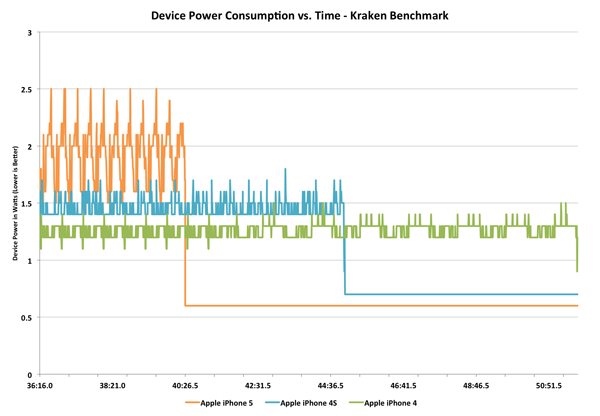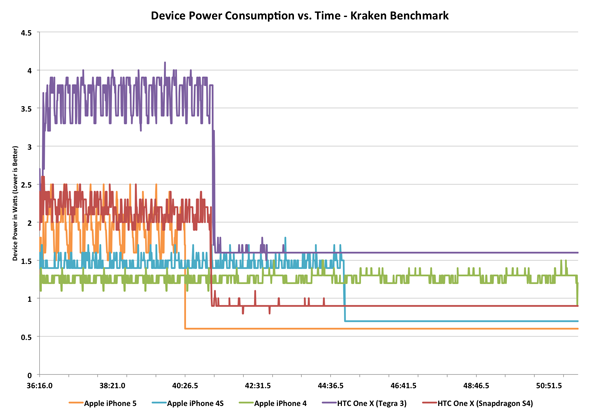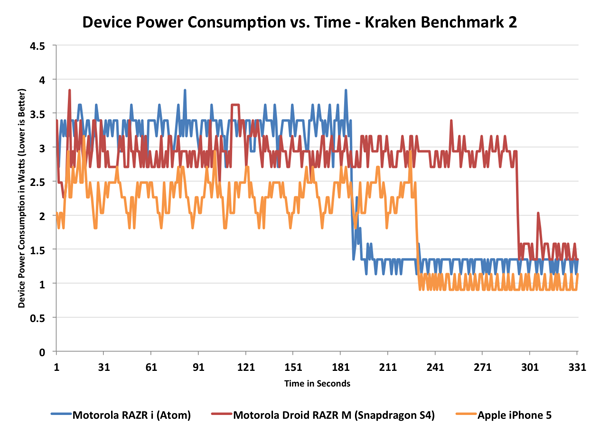The iPhone 5 Review
by Anand Lal Shimpi, Brian Klug & Vivek Gowri on October 16, 2012 11:33 AM EST- Posted in
- Smartphones
- Apple
- Mobile
- iPhone 5
Increased Dynamic Range: Understanding the Power Profile of Modern SoCs
Section by Anand Shimpi
The iPhone 4S greatly complicated the matter of smartphone power consumption. With the A5 SoC Apple introduced a much wider dynamic range of power consumption to the iPhone than we were previously used to. Depending on the workload, the A5 SoC could either use much more power than its predecessor or enjoy decreased overall energy usage. I began our battery life analysis last time with some graphs showing the power savings realized by a more power hungry, faster CPU.
The iPhone 5 doesn't simplify things any more. I believe the days of us having straightforward discussions about better/worse battery life are long gone. We are now firmly in the era of expanded dynamic range when it comes to smartphone power consumption. What do I mean by that? The best way to explain is to look at some data. The graphs below show total device power consumption over time for a handful of devices running the Mozilla Kraken javascript benchmark. Kraken is multithreaded and hits the CPU cores fairly well. The power profile of the benchmark ends up being very similar to loading a very js-heavy web page, although for a longer period of time. All of the device displays were calibrated to 200 nits, although obviously larger displays can consume more power.
Let's start out by just looking at the three most recent iPhone generations:
The timescale for this chart is just how long the iPhone 4 takes to complete the Kraken benchmark. The iPhone 4/4S performance gap feels a lot bigger now going back to the 4 than it did when the 4S launched, but that's how it usually seems to work. Note how tight the swings are between min and max power consumption on the iPhone 4 during the test. As a standalone device you might view the iPhone 4 as being fairly variable when it comes to power consumption but compared to the 4S and 5 it might as well be a straight line.
The 4S complicated things by consuming tangibly more power under load than the 4, but being fast enough to complete tasks in appreciably less time. In the case of this Kraken run, the 4S consumes more power than the 4, however it's able to go to sleep quicker than the 4 and thus draw less power. If we extended the timeline for the iPhone 4 significantly beyond the end of its benchmark run we'd see the 4S eventually come out ahead in battery life as it was able to race to sleep quicker. The reality is that with more performance comes increased device usage - in other words, it's highly unlikely that with a 50% gain in performance users are simply going to continue to use their smartphone the same way as they would a slower device. Usage (and thus workload) doesn't remain constant, it's somewhat related to response time.
The iPhone 5 brings new meaning to device level power consumption. With a larger display and much more powerful CPU, it can easily draw 33% more power than the 4S under load, on average. Note the big swings in power consumption during the test. The A6 SoC appears to be more aggressive in transitioning down to idle states than any previous Apple SoC, which makes sense given how much higher its peak power consumption can be. Looking at total energy consumed however, the iPhone 5 clearly has the ability to be more power efficient on battery. The 5 drops down to iPhone 4 levels of idle power consumption in roughly half the time of the iPhone 4S. Given the same workload that doesn't run indefinitely (or nearly indefinitely), the iPhone 5 will outlast the iPhone 4S on a single charge. Keep the device pegged however and it will die quicker.
Out of curiosity I wanted to toss in a couple of other devices based on NVIDIA and Qualcomm silicon to see how things change. I grabbed both versions of the HTC One X:
The Tegra 3 based One X actually performs very well in this test, but its peak power consumption is significantly worse than everything else. It makes sense given the many ARM Cortex A9 cores built on a 40nm G process running at high clock speeds on the Tegra 3.
The 28nm Snapdragon S4 (dual-core Krait) based One X gives us some very interesting results. Peak power consumption looks identical to the iPhone 5, however Apple is able to go into deeper sleep states than HTC can with its S4 platform. Performance is a little worse here but that could be a combination of SoC and software/browser. I used Chrome for all of the tests so it should be putting Android's best foot forward, but the latest update to Safari in iOS 6 really did boost javascript performance to almost untouchable levels.
At the end of the day, the power profile of the iPhone 5 appears to be very close to that of a modern Snapdragon S4 based Android smartphone. Any battery life gains that Apple sees are strictly as a result of software optimizations that lead to better performance or the ability to push aggressively to lower idle power states (or both). It shouldn't be very surprising that these sound like a lot of the same advantages Apple has when talking about Mac battery life as well. Don't let the CPU cores go to sleep and Apple behaves similarly to other device vendors, but it's really in idle time or periods of lighter usage that Apple is able to make up a lot of ground.
There's one member of the modern mobile SoC market that we haven't looked at thus far: Intel's Medfield. The data below isn't directly comparable to the data above, my measurement methods were a little different but the idea is similar - we're looking at device level power consumption over time while Kraken runs. Here I'm only focusing on the latest and greatest, the Atom based Motorola RAZR i, the Snapdragon S4 based Droid RAZR M and the iPhone 5. The RAZR i/M are nearly identical devices making this the perfect power profile comparison of Atom vs. Snapdragon S4. The RAZR i is also the first Atom Z2460 based part to turbo up to 2.0GHz.
Very interesting. Atom is the only CPU that can complete the Kraken benchmark in less time than Apple's Swift. Peak power consumption is definitely higher than both the Qualcomm and Apple devices, although Intel's philosophy is likely that the added power usage is worth it given the quicker transition to idle. Note that Atom is able to drive to a slightly lower idle level than the Snapdragon S4, although the Swift based iPhone 5 can still go lower.
At least based on this data, it looks like Intel is the closest to offering a real competitor to Apple's own platform from a power efficiency standpoint. We're a couple quarters away from seeing the next generation of mobile SoCs so anything can happen next round, but I can't stress enough that the x86 power myth has been busted at this point.
I will add that despite Intel's performance advantage here, I'm not sure it justifies the additional peak power consumption. The RAZR i ends up being faster than the iPhone 5 but it draws substantially more power in doing so, and the time savings may not necessarily offset that. We'll see what happens when we get to our battery life tests.













276 Comments
View All Comments
ArmedandDangerous - Tuesday, October 16, 2012 - link
What ever happened to the One X International review that was promised when you were reviewing the US version? Lots of promised articles and reviews that were never ever done...MrCake - Wednesday, October 17, 2012 - link
Yeah, already posted this comment for podcast 8, but it bears repeating. I'm less angry now, but still facepalming.It's not my expertise but I have designed a few hundred aluminum parts, so here's how it probably
works. The call-out is most likely equivalent to mil-std-171 7.2.2; this is a ~.0005" thickness coat,
decorative and scratch resistant. The coating itself is super hard, and can only be scratched by harder materials. The problem is the base metal yield strength is still fairly low. Chamfers (yes, we do pronounce the "h") have sharp edges, which make point contacts and therefore have theoretically infinite contact stresses till they're rounded off. To summarize; small contact areas, equal high pressures even at low forces; pressures over material yield cause deformations, and deformations over .0005" make you see silver. The chamfer finish is probably not a post anodization process,it's diamond ground and has a much finer surface finish. The rest of the phone is cnc milled, and is matte from either a sandblasting, or vibratory media process to remove machining marks. Anodize surfaces are as glossy/matte as their surface finish. And as to the "structural integrity" concern repeated, and repeated, and repeated; The iphone is thin, but the anodize coating is a couple orders of magnitude thinner and has negligible affect on structural integrity.
A possible fix would be mil-std-171 7.5.2 Anodize Type III which is an anodized hardcoat. It's a
similar process but coats to .002" thick, packs it's molecules much denser, and can pass a hardness test to rockwell C60. It's a reasonable response to the scratching issue, however it may not be appropriate for other reasons(prone to cracking instead of scratching, tolerance issues, more costly, less pretty.)
syxbit - Wednesday, October 17, 2012 - link
Great job guys. I'd appreciate it if you went into as much detail on the upcoming Nexus device(s).KPOM - Wednesday, October 17, 2012 - link
They will.WooDaddy - Wednesday, October 17, 2012 - link
I didn't RTFA (as if I need to question Anand consistently excellent analysis as it has been Anandtech's inception), but as soon as I saw the phrase 'murdered out' regarding the black/slate color, I was done. It was like Anand was at a poetry slam and he dropped the mic signifying that there is no one better.VivekGowri - Wednesday, October 17, 2012 - link
Hey, hey, I wrote that part :Pjuhatus - Wednesday, October 17, 2012 - link
iPhone review.. what about..Does it work as a phone??
SJD - Wednesday, October 17, 2012 - link
Don't know if I'm the first one to say this, but the HTC One S battery isn't removable. (At least it isn't over here in the UK - don't know if your version in the US is any different).Table - Physical Comparison - Page 1
Origin64 - Wednesday, October 17, 2012 - link
I do really want to point out that the iPhone 5 being 20% lighter than the 4 isn't really substantial, seeing as how a Galaxy S 1 weighs about half of that.Apple has excellent construction quality, but they build their phones from glass and aluminium and they are heavier than the competition. There's no advantage here, no breakthrough, the iPhone 5 is just a different design that has a thinner battery and less glass. It's not as interesting as you make it seem.
thunng8 - Wednesday, October 17, 2012 - link
What are you on about? The Galaxy S weighs 119g and the iphone 5 weighs 112g.